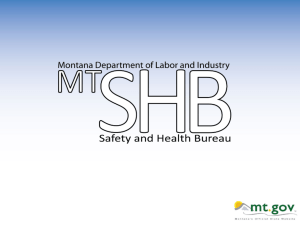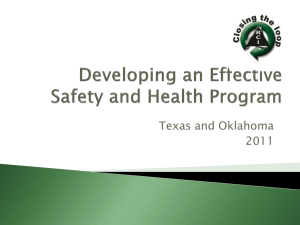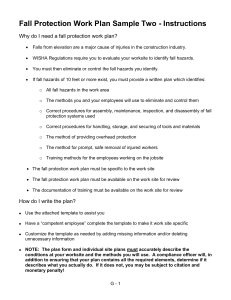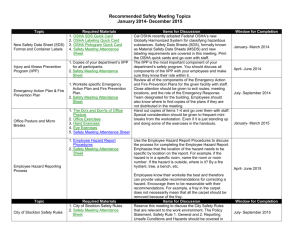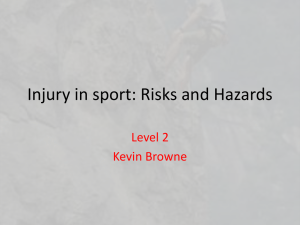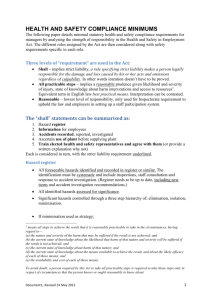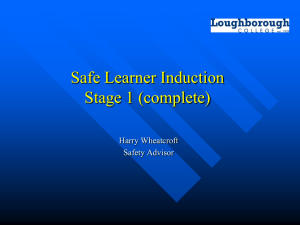OSHA Managing Safety and Health Guidelines, Non Mandatory
advertisement
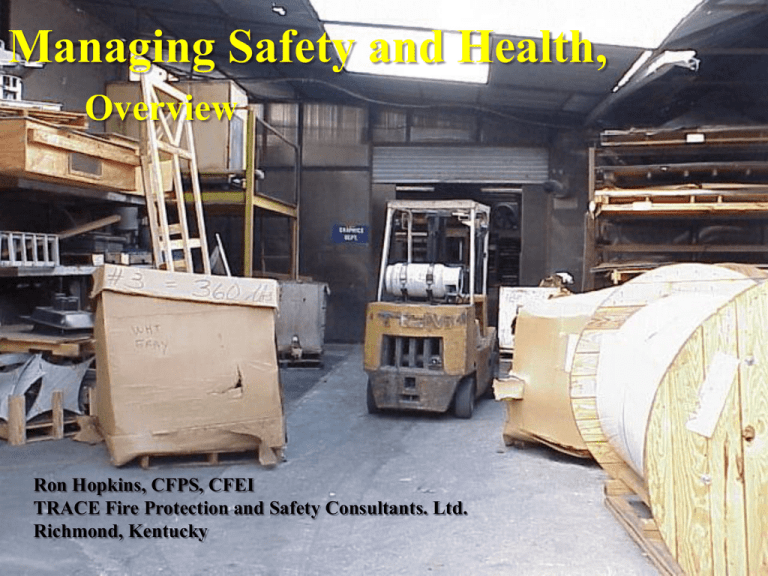
Managing Safety and Health, Overview Ron Hopkins, CFPS, CFEI TRACE Fire Protection and Safety Consultants. Ltd. Richmond, Kentucky Section Objectives Upon successful completion of this section, each participant will be able to: 1. Discuss the costs of accidents and the benefits of safety and health programs. 2. Describe the OSHA requirements and guidelines for safety and health programs in general industry. I. Introduction Research indicates benefits to companies who establish effective worker safety and health programs: • Reduction in the extent and severity of work-related injuries and illnesses • Improved employee morale • Higher productivity • Lower workers’ compensation costs A. Exemplary Workplaces Common characteristics of effective safety and health programs: • Assignment of responsibility to managers, supervisors, and workers • Regular inspections to control hazards • Employee training and orientation for the recognition and avoidance of hazards B. Cost of Accidents 1. 45 billion dollars 2. 3.9 million lost workdays (average 20 days) 3. 1 out of 20 will suffer serious injury or illness 4. Pain and suffering 5. Damage to environment 6. Morale of employees C. Cost of Accidents Direct Accident Costs Indirect Accident Costs Cost of Accidents 1. Direct Accident Costs • • • • Medical (30% increase) Insurance premiums (30% increase) Employee compensation (long term) Long term cost (medical / legal) Loss of Credibility with workforce Legal and medical cost Cost of Accidents 2. Indirect Costs • • • • • • • • • Equipment/material Replacement cost Overtime pay Lost sales Hire and train new employees Investigate accident Worker’s compensation Clean up Repair damaged area Loss of Credibility with workforce Legal and medical cost D. Causes of Accidents and Illnesses Accidents / Illnesses Hazardous Acts Hazardous Conditions Unaware Unable Unmotivated Unidentified Uncorrected Proactive Safety and Health Management H. W. Heinrich’s Theory Fatal Major Injury Property/Injury Minor Property Near Miss 1. Fatalities 4,547 workers died on the job in 2010 14 Fatalities August 12 to October 5, 2011* Source: www.osha.gov/dep/fatcat/fatcat_weekly_rpt_10082011.html 12/7/2011 II. Safety and Health Programs A. S & H Program Guidelines Systematic approach to hazard: • Identification • Evaluation • Control S & H Program Guidelines • As the size of the workplace increases so does the need for a formalized written program • Program effectiveness more important than “In Writing” Elements taken from the ‘Safety and Health Program Guidelines - 1989’ B. Major Elements An effective occupational safety and health program includes the following four elements: Management commitment and employee involvement Worksite analysis Hazard prevention and control Safety and health training 1. Management Commitment Policy and Goals • Clearly state a worksite safety and health policy • Establish and communicate a clear goal and objective for the safety and health program • Involve top management in implementing the program 2. Employee Involvement • Encourage employees to get involved in the program and in decisions that affect their safety and health • Communicate responsibility for all program aspects 3. Responsibility • Parties responsible for the safety and health program must have authority and resources • Managers, supervisors, and employees must be held accountable for meeting their responsibilities • Program operations must be reviewed at least annually, to evaluate, identify deficiencies, and revise, as needed 4. Worksite Analysis Examine the worksite and identify: • existing hazards • conditions and operations where changes might occur to create hazards Management must actively analyze the work and the worksite to anticipate and prevent harmful occurrences 5. Comprehensive Survey Conduct a comprehensive baseline survey for safety and health Hazard and Risk Assessment Job Task Analysis Job Safety Analysis 6. Safety and Health Inspections • Conduct regular (usually weekly) site inspections • Establish daily work area inspection procedures •Develop and use a checklist • Provide a reliable system for employees, without fear of reprisal, to notify management about apparent hazardous conditions and to receive timely and appropriate responses 7. Additional Worksite Analysis • Investigate accidents and “near miss” incidents, so that their causes and means for prevention are identified • Analyze injury and illness trends, so that common cause patterns can be identified and prevented 8. Hazard Prevention and Control • Start by determining that a hazard or potential hazard exists • Where feasible, prevent hazards by effective design of job or job site • If the hazard cannot be eliminated, use hazard controls • Eliminate or control hazards in a timely manner 9. Safety and Health Training • Safety is a Skill! Essential Elements of an Effective Safety and Health Program • Management Commitment and Employee Involvement • Worksite Analysis • Hazard Prevention and Control • Effective Safety and Health Training Managing Safety and Health, Overview Questions? Ron Hopkins, CFPS, CFEI Instructor, EKU OSHA Ed Center Eastern Kentucky University
